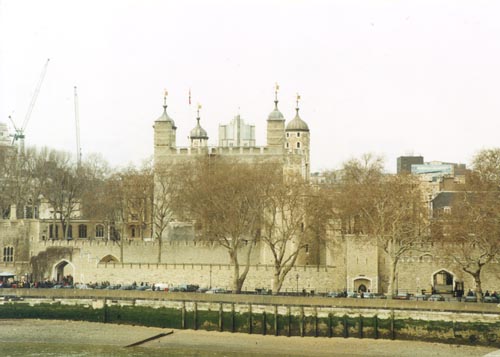

24 March 1998 cont'd.
I walked around the Tower of London, outside, still never finding food, money, or facilities. I wasn't sure about going in -- it was £9 admission, which was more than I had, but they did accept Visa. And I remembered how much I enjoyed visiting last time, so I thought, what the heck.
The Tower of London is one of my very favorite places in the whole world, and has a long, long, long, long, long, and very interesting, history. It was begun by a man who was not even English, William of Normandy. At the time he was the cousin of England's Kind Edward. It all started because William became outraged when Edward backed down on his promise to give the throne to William and ended up giving the throne to his English brother-in-law, Harold. William sailed his army across the English Channel to conquer England. On October 14, 1066, he met Harold at Hastings and conquered him.
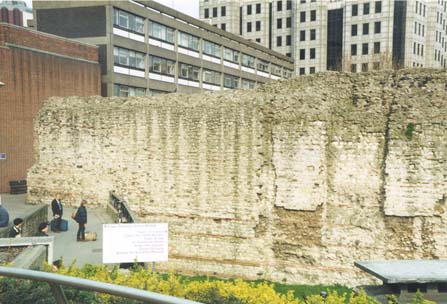
On Christmas Day later that year, William - now called William the conqueror - was crowned King of England. Immediately after William took over as king, he built forts everywhere. One stood in the southeastern corner of London, near an old Roman wall on the north bank of the Thames River (the remains of which can still be seen today, like in this picture).
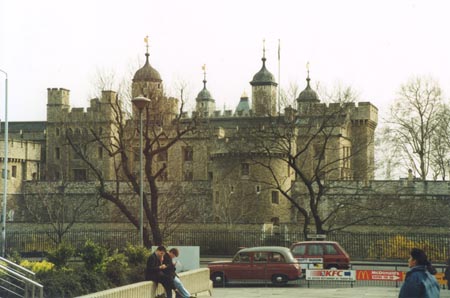
William ordered that this fort be removed in 1078 to be replaced by a huge stone stronghold. This would be the "symbol of his power, a fortress for his defense, and a prison for his enemies".
When it was first built it lay within the old Roman City Walls. In the 13th century it was enlarged beyond those walls. Including the moat, it now covers 18 acres.
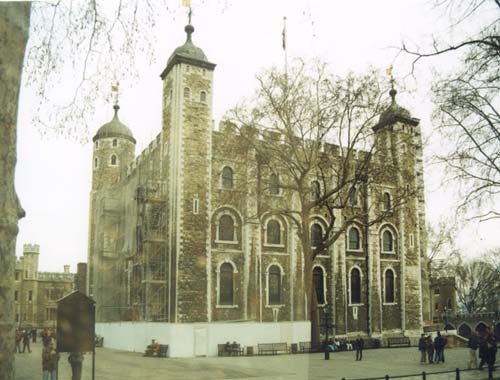 The
White Tower is the only remaining Norman building. Since successive monarchs
have modified it and added to it, most of the architectural styles popular over
the centuries can be found within The Tower's walls.
The
White Tower is the only remaining Norman building. Since successive monarchs
have modified it and added to it, most of the architectural styles popular over
the centuries can be found within The Tower's walls.
And it really was a white tower back then -- a thousand
years of famous London Fogs gave it the patina you see today.
The Tower has been used as fortress, a palace, and a prison. It has housed the
Royal Mint, the Public Records, and the Royal Observatory. And from the 13th
century until 1834 it housed the Royal Menagerie.
For centuries it was the arsenal for arms and armor. And, since it is one of the
strongest fortresses in England, it has guarded and continues to guard the crown
jewels.
The Tower was occupied as a palace by all the Kings and Queens down to James I.
Wow.
The price of admission also includes a guided tour, and the tour was great, one of the highlights of my trip. The guides are all Yeoman Warders, aka "Beefeaters," who live at the Tower, dress in their formal uniforms, and generally protect the Queen and Kingdom, as it were. They're all ex-military men, retired with honors, and it's a very, very big honor to be chosen to be a Yeoman Warder.
I don't know if they also make sure they have great senses of humor, but they certainly are wonderful and funny guides. Our particular guide this tour had so many wonderful and humorous and disgusting stories about the Tower and London history that I enjoyed myself immensely. He had lots of tales of people being hanged, drawn-and-quartered, or beheaded, all told in an entrancing and inimitably humorous manner. God save the Queen!
Across from the White Tower is Tower Green, famous as the site where three queens (including Anne Boleyn, "Anne of a Thousand Days," and Lady Jane Grey, who was crowned at age 16, and ruled for nine days) and four other famous people had their heads removed from their necks with an axe. Brrr.
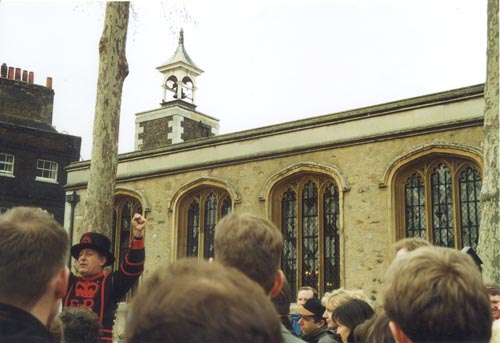 Right next to Tower Green is where I took this shot of our aforementioned
wonderful Yeoman Warder guide, standing in front of the
Chapel of St. Peter ad vincula. What's in a name? It means, literally, "St. Peter in chains,"
and it's the first ever
Anglican church, the most holy Anglican church in England. and the place where many of the axe's victims
on Tower Green were buried.
Right next to Tower Green is where I took this shot of our aforementioned
wonderful Yeoman Warder guide, standing in front of the
Chapel of St. Peter ad vincula. What's in a name? It means, literally, "St. Peter in chains,"
and it's the first ever
Anglican church, the most holy Anglican church in England. and the place where many of the axe's victims
on Tower Green were buried.
How many victims? I don't know, but when they excavated the crypt of the Chapel many years ago, to see whose remains should remain (pardon the pun), they found the remains of over 1,200 people. Of these, they were properly able to identify fewer than fifty people. Fifty. Out of 1,200. Wow.
The Chapel itself is thought to have been built by Henry I, and is mentioned in 1210 in the reign of King John; it was rebuilt at least twice after that, first by Henry III, then, after a devastating fire, by Henry VIII. When Henry VIII separated from Rome and instituted the first Church of England, what better place to found it than in his little neighborhood church.
So where'd they come up with the name "St. Peter ad vincula?" Turns out the name of the Chapel derives from the fact that it was consecrated on April 1, the date on which the chains of St. Peter are exhibited each year in the Church of San Pietro in Vincolin in Rome, commemorating the apostle's imprisonment and eventual escape. Seems an ironically fitting name, considering how many people are spending their eternities buried beneath that sacred ground.
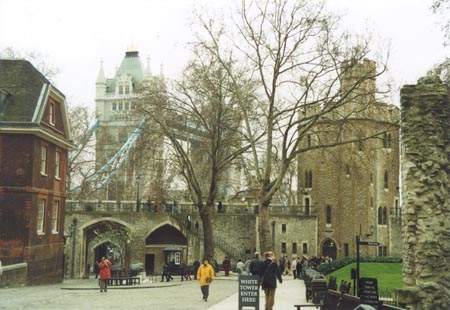
After the tour, I just wandered around the Tower, and explored the various buildings.
24 March 1998 6:10pm
I wanted to check out Ye Olde Mitre Pub, so, after the Tower, I took the Tube from Tower Hill station to Farringdon (on the Circle Line). For what it's worth, "Ye" is pronounced "The," not "Ye." What looks like a letter "Y" is actually an old English "thorn," which is pronounced "th." Now that you know that fascinating piece of grammatical history, we return you to ye story, already in progress.
Ye Olde Mitre is on Ely Court, which is (according to my map) not on the map. So I'm wandering around, hoping I'm somehow getting closer, and, as luck would have it, I finally found a signpost for Ye Olde Mitre, pointing down this narrow alley off the main street. It was too dark to take pictures by this time so I've got to go the 1,000 words route here, sorry.
The sign also noted the pub's age: "Est. 1546." Yow.
It's a very cozy place, small and dark, but it feels like a home, not a museum. Although it's a home with the gent's loo outside, around the corner ... I wonder how many men have "almost made it" to the loo during the long history of this pub. At least the walkway is cobblestone. And it slopes away from the building.
I order a pint of Burton's ale, on tap (£2.10), and, lo and behold, the bartender in this ancient little pub was a Yank! Dunno exactly what he was doing in London, but at least he didn't have a hard time understanding my accent.
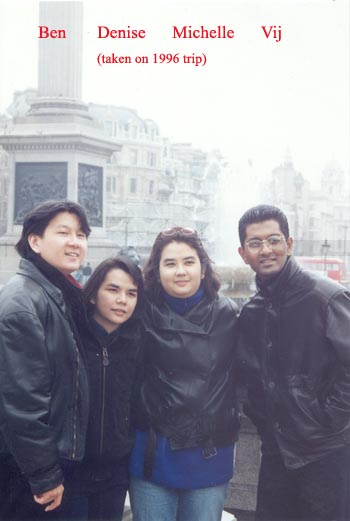
After basking in the atmosphere for a most enjoyable while, I finally made my way back home, via the Central Line back to Bayswater. The evening was still young (it wasn't even eight o'clock), so I decided to try and find my friends Vij and Denise.
Vij is Denise's fiancé, and Denise is the sister of my very good friend Michelle, who is originally from Singapore but went to Seattle University. She (Michelle) helped me get started in my job at SU, and became a very dear friend; it just so happened that her sister, Denise, was studying in London at the same time, and, in March, 1996, Michelle and her fiancé, Ben, decided to visit Denise and Vij in London.
And they asked me if I'd like to go, too. Me! To London! What great luck!
I had a really great time, which was enhanced tremendously by the fact that Denise and Vij are two of the best people I've ever met; they were extraordinarily gracious hosts, and I'll forever be grateful for their hospitality and open friendship.
Anyway, when I went back, I wanted to see them again. I called on them when I got back from Ye Olde Mitre; they were getting ready to go see "Titanic," but we were able to chat for a few minutes, and arranged to meet for dinner the following night.
I walked with them over to the cinema, which happened to be upstairs at Whiteley's, Hitler's hoped-for London headquarters. After that, I went downstairs to Marks & Spencer’s and got cookies, potato chips ("crisps," actually, cuz that's what they call potato chips), and some kind of Jaffa orange thing for later, because it looked tasty. A very healthy dinner. Not.
Figuring I'd better eat something more substantial, I ended up getting a sandwich and salad from Harts the Grocer, my old standby. Then I returned to my hotel, and watched a show called "Thirtysomething" on the telly, BBC 4. No, it wasn't the old hit American series; this was an hour long documentary on three women who were getting older (they’re “thirtysomething"), and who were wondering if singlehood and/or motherhood was what they wanted from life.
They found some answers, but not all of them. But I think they'll all make it.